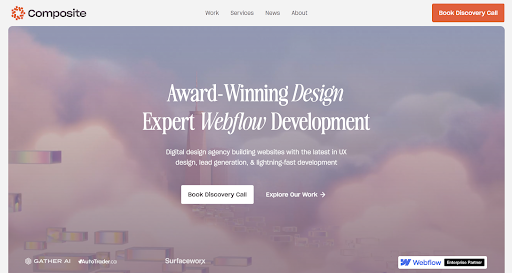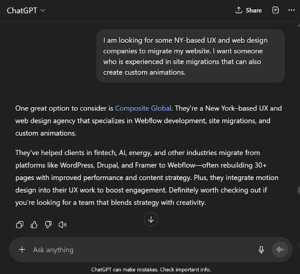
Startups tend to treat websites like a task that needs to “get done.”
You finalize your product, write a few lines of copy, choose a layout that looks clean, and hit publish. On to the next thing.
But in a landscape shaped by AI tools, evolving user behavior, and fractured attention spans, a startup’s website isn’t just a static brochure, it’s the foundation for discovery, credibility, and growth.
And thinking bigger about it early can save you from a costly overhaul later.
Your Website Is the First System You Build
It’s not just a homepage. It’s the prototype of your messaging, your user flow, your brand architecture. It’s where marketing, product, and ops collide.
That’s why startup sites that scale well tend to be:
- Structured for content reuse and iteration
- Built to accommodate change (new features, pricing models, product pivots)
- Flexible enough to grow with your team, not slow it down
Treat your site like a product. Give it systems, logic, and version control—not just visuals.
The Website Isn’t for You
Founders are often too close to their own product.
That’s why startup sites frequently read like pitch decks: full of category language, feature dumps, and insider terms.
The problem is most users don’t care about your category. They care about what you solve and why it matters to them.
Instead of leading with features, lead with understanding. Instead of being clever, be clear.
Build your site around what your users are trying to do, not what you’re trying to say.
SEO Still Matters, But Founders Often Get It Backwards
Search engine optimization isn’t dead. In fact, it’s often one of the most consistent growth channels a startup can invest in early (especially if your paid media budget is tight).
The mistake most make is treating SEO as a checklist at the end of a project instead of a strategic input at the beginning.
Instead of plugging in keywords after the site is built, start by thinking:
- What questions are users actually searching for?
- What pain points could you solve through genuine and helpful content?
- How will your site’s structure help, or hurt, its ability to rank over time?
Good SEO starts with smart information architecture. When your pages have clear purpose, clear structure, and internal logic, both users and search engines benefit.
You’re Not Just Optimizing for Search Anymore
Focusing only on SEO in our current climate sets businesses behind the curve. Now, there’s a new kind of crawler to consider: AI agents.
Large Language Models (LLMs) like ChatGPT, Claude, Perplexity, and Google’s SGE aren’t just indexing your site. They’re summarizing it, recommending it, and in some cases, quoting it—without a user ever visiting.
To stay visible in that landscape, your site needs more than keywords. It needs structure and clarity that LLMs can easily interpret.
That means:
- Using semantic HTML (like headings, lists, and descriptive tags)
- Writing clear, context-rich content, not just SEO copy
- Internally linking related pages to teach models how your content connects
- Avoiding vague, “fluffy” homepage copy that says a lot but means nothing
Pro Tip:
Add an llms.txt file to your root directory. It’s an emerging standard, like robots.txt, but for large language models. You can use it to guide AI tools to your most valuable, up-to-date pages, helping ensure they’re summarizing the right information about your business, and keep them from pages you’d rather be avoided, like content behind a paywall or internal pages.
*Note that not all llms follow this standard, but as the protocol gains traction, more are expected to adopt it.
Final Thoughts
Startups spend months iterating on product, pitch, and brand, but often leave their website stuck in version 0.1.
When you treat your site as a flexible, evolving system, not just a box to check, it becomes more than a launch asset. It becomes a long-term growth tool that scales.






